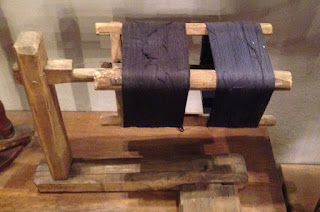


We hired a driver for a week. He picked us up in Tbilisi and drove us out to the deep countryside. He was dignified and kind and clear eyed. He is Georgian and had graduated from a veterinary school in Moscow. He oversaw the chicken and cow veterinarians working at 150 farms in Georgia. When the Soviet Union collapsed in 1991 he was out of work.The last animals were eaten and the farm buildings and machinery were sold to Turkey for money for food.
When Putin said that the second greatest tragedy of the 20th century was the collapse of the Soviet Union I snickered. "Good riddance to it." I thought. I couldn't imagine all the human suffering the collapse unleashed. I was just thinking of all the suffering it was ending.
He (the driver, not Putin) had see how excited we were at the State Silk Museum. A few days later he took me in the van for a drive. I could see he was looking for somewhere specific. We turned right and had the Azerbaijan border right in front of us.
Wrong road.
We turned back and drove along the center of this valley.
(Please click photo to see the whole picture.)


He stopped in front of a house and went and knocked on the door. I got out and took a photo of this place across the street and dreamed a little "fix-it-up" dream for me.
He came over and invited me to go into the house. He had met the woman who lives there 25 years before and remembered that she was using natural dyes and weaving carpets.
He had searched her out to introduce us to each other.
We didn't share a common language. The conversation in English went to Russian and then on to Georgian. You have to keep a lot of eye contact so if the words are lost, the emotions and intentions are at least somewhat apparent. I hope that they could read the gratitude on my face.
Lilli lives in this wonderful traditional Georgian wooden house. She was a silk farmer for her whole life. 500 kilograms of cocoons a year. She quit when the Soviet Union collapsed. No place to sell the silk.
She gets sheep wool from her neighbour and cards and spins it. She proudly/humbly proclaimed she gets 50 colours from local natural berries, roots and barks.

The blue (obviously indigo pigment) she gets from a TREE BARK!!! I thought I knew just about everything about indigo and I get tsunamied with that information.
Indigo from bark????? I had to go back and forth through the translation chain three times in disbelief.
True.
I had only an iPhone with less than 10% battery left. I tried to show her some pictures of my silk farm and the vegetable dyes I use and some things I weave. Just enough to let her know that I am her brother.
I tried to follow my "Visiting artist's studio rules". Look
and shop and leave. But it was hard. I had severe separation anxiety.


Perhaps she sensed this or it was that famous Georgian hospitality but we soon found ourselves at a lavish lunch that materialized out of nowhere in her cellar room. All the wines and liquors she had made herself. The wool suppling neighbour also made sheep cheese. It was wrapped tightly in a sheepskin and fermented for one year. ( It was so delicious I thought I had died and gone to a Greek island.)

We toasted in the Georgian style. (The goal seems to be to move the others to tears with honesty and gratitude and all those other tear jerking emotions. )When it was my turn to give a toast I think I did a good job....it got my tear ducks (sic) swimming. For the last toast we toast the angel above each door that will guard us as we travel to the next door.
There was my most memorable textile day on that five week vacation. Not even planned. Someone gave it to me.
Like Japan there are these master craftspeople living quiet almost unrecognized lives of dedication to their craft. I purchased those socks and leggings on our laps in the picture. Unfortunately, I only had a stack of roubles and yen in my wallet. Just 50 Georgian laris. There were some carpets and bed covers that would have looked so good in this old Japanese house.



















































